👾 Metamorphosis
Definition, Types, Immature Stages in Insects
Which of the following statment is incorrect?
- Metamorphosis is the change in growth and development an insect undergoes during its life cycle from birth to maturity.
- Metamorphosis is derived from Greek word meta = Change, morph = form or structure.
- The presence of hard exoskeleton on the body prevents the growth of larva.
- The series of moults during larval stage allow them to increase their body size/growth.
- The number of moults in general may vary from 5-6.
Types of metamorphosis
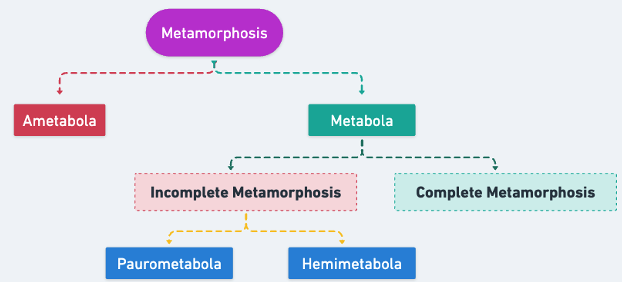
Ametamorphosis

- Insects do not undergo any metamorphosis (No Metamorphosis).
- When the insect hatches from the egg, it resembles the adult in all the characters except the small body size, which later increases, until they reach sexual maturity with well-developed reproductive organs.
- E.g.: Apterygotes: silver fish, springtails.
Incomplete Metamorphosis
- Also known as Hemi-metamorphosis or Direct Development or Simple Metamorphosis
- The life cycle includes egg, nymph and adult stages. The nymph resembles the adult in all the characters except wings. Nymphs possess wing buds which transform into fully developed wings in adult stage.
- In these insects, wings develop externally and hence are also called as Exopterygota.
- Pupal stage is absent hence, development is said to be direct and simple.
Egg –> Nymph –> Adult
Paurometabola
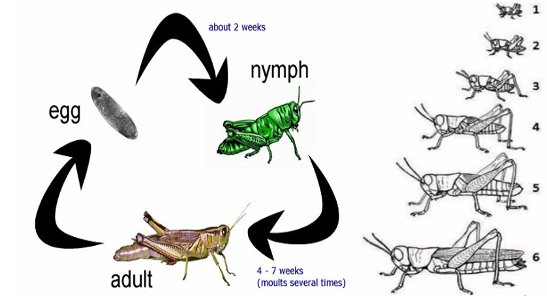
- Means gradual metamorphosis, a type of incomplete metamorphosis.
- The young ones are called nymphs. They are terrestrial and resemble the adults in general body form except the wings and external genitalia. Their compound eyes and mouth parts are similar to that of adults.
- Both nymphs and adults share the same habitat.
- Wing buds externally appear in later instars. The genitalia development is gradual.
- Later instar nymphs closely resemble the adult with successive moults.
- E.g.
- Orthoptera: e.g.
Locust,Grasshopper,Cockroach - Thysanoptera: e.g. Thrips
- Isoptera: e.g. Termites
- Hemiptera: e.g. Aphids, Leaf hoppers
- Orthoptera: e.g.
Hemimetabola

- Means incomplete metamorphosis.
- These insects also have three stages in their life namely egg, young one and adult. The young ones are aquatic and are called as naiads. They are different from adults in habit and habitat.
- They breathe by means of tracheal gills. In dragonfly naiad the lower lip (labium) is called mask which is hinged provided with hooks for capturing prey. After final moult, the insects have fully developed wings suited for aerial life.
- Odonata: e.g. Dragonfly, damselfly and may fly.
Holometamorphosis
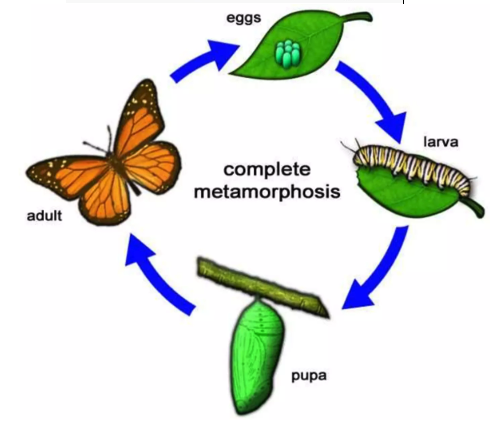
- Means
complete metamorphosis. - The life cycle includes four stages; egg, larva, pupa and adult. Hence known as Indirect Development.
- Majority of insects undergo complete metamorphosis.
- Larva differs from the adult both in body structure and habits.
- Larva has both thoracic and abdominal legs, sometimes legs may be absent in larva, whereas adult has only thoracic legs.
- Compound eyes are absent in larva. Larva undergoes moulting to enter into pupal stage from which the adult insect emerges.
- Wings develop internally during the pupal stage and hence, they are called Endoptreygotes.
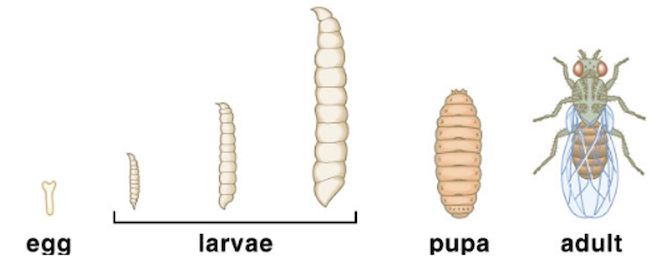
Egg –> Larva (Caterpillar) –> Pupa –> Adult
- E.g.:
- Coleoptera: e.g. Beetles, Weevils
- Lepidoptera: e.g. Moths, Butterflies, Silkworm
- Diptera: e.g. Flies.
- Hymenoptera: e.g. Sawflies, Bees, Ants, Wasps,
Immature Stages in Insects
Egg
- The first stage of development in all insects is egg.
- Majority of insects are oviparous.
- The outer protective shell of the egg is called chorion.
- Types of eggs.
Singly laid eggs
- Sculptured egg: Chorion with reticulate marking and ridges e.g. Castor butterfly
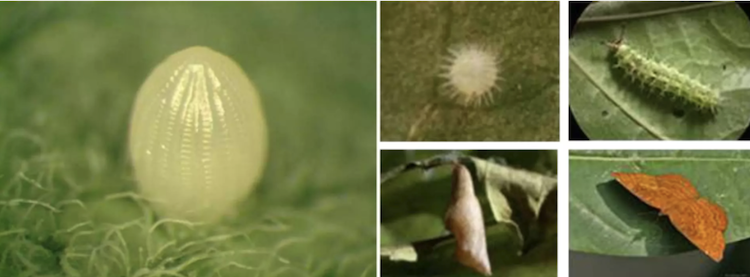
- Elongate egg: Eggs are cigar shaped. e.g. Sorghum shoot fly.
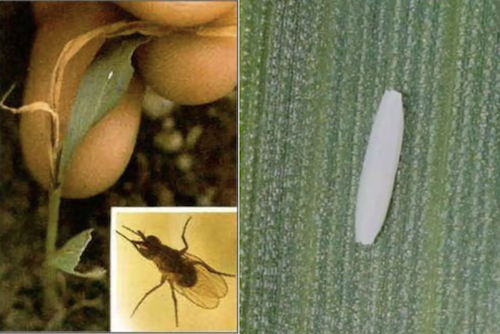
- Rounded egg: Eggs are either spherical or globular. e.g. Citrus butterfly

- Nit: Egg of head louse is called nit. It is cemented to the base of the hair.
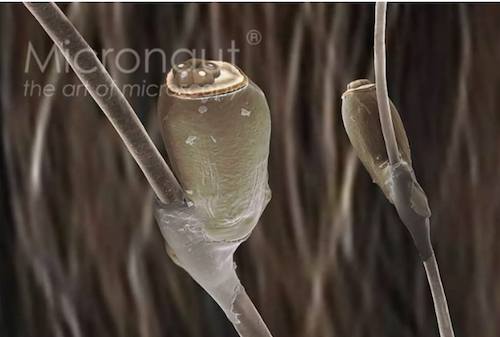
- Egg with float: Egg is boat shaped with a conspicuous float on either side. The lateral sides are expanded which act as floats. E.g. Anopheles mosquito.

Eggs laid in groups
- Pedicellate eggs: Eggs are laid in silken stalks of about 1.25mm length in one group on plants. e.g. green lacewing fly.
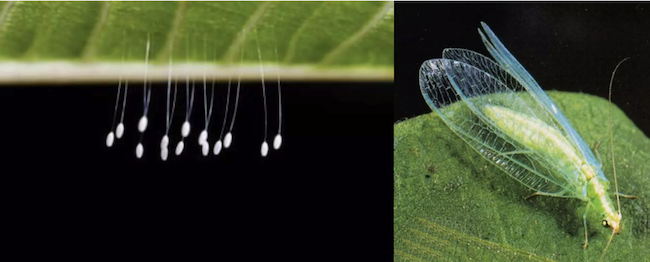
- Barrel shaped eggs: E.g. Stink bug.
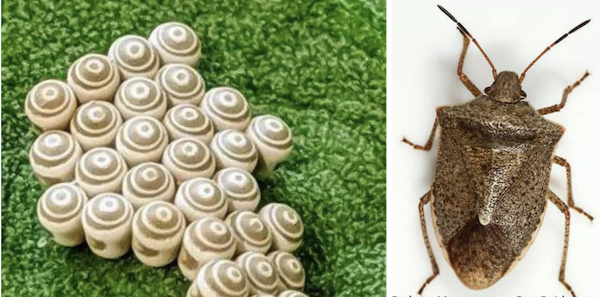
- Ootheca: Eggs are deposited by cockroach in a brown bean like chitinous capsule.
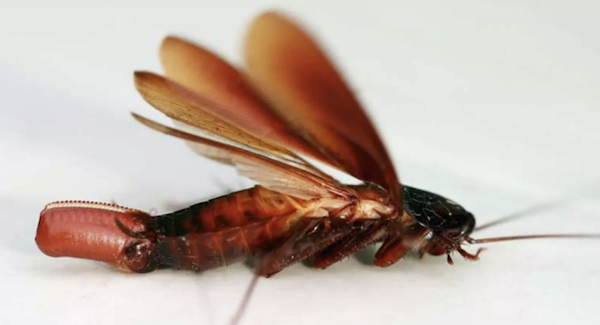
- Egg pod: Grasshoppers secrete a frothy material that encases an egg mass which is deposited in the ground. The egg mass lacks a definite covering. On the top of the egg, the frothy substance hardens to form a plug which prevents the drying of eggs.

- Egg case: Mantids deposit their eggs on twigs in a foamy secretion called spumaline which eventually hardens to produce an egg case or ootheca.
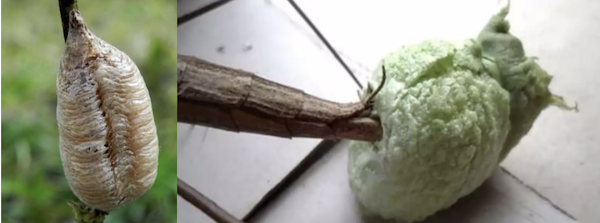
- Egg mass: Moths lay eggs in groups in a mass of its body hairs. e.g. Rice stem borer.
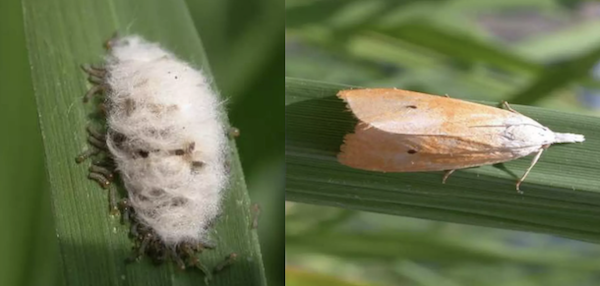
- Egg raft: In Culex mosquitoes, the eggs are laid in water as a compact mass consisting of 200-300 eggs called egg raft.
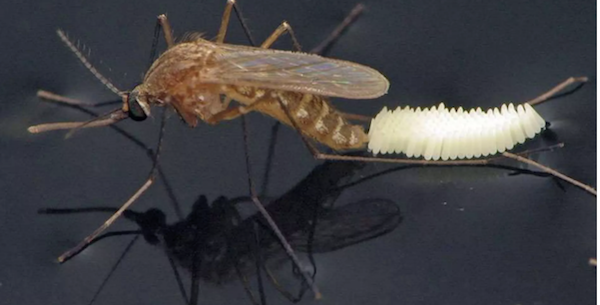
Larvae
- Larval stage is the active growing stage.
- It is the immature stage between the egg and pupal stage of an insect having complete metamorphosis.
- This stage differs radically from the adult.
- Nymph: The Larva (immature stage) of Orthoptera (Grasshoppers/locusts) and Hemiptera (Bugs, Hoppers, Whiteflies, Aphids, Jassids).
- Caterpillar: Larva of Lepidoptera (Butterflies/Moth), Bollworm, Borer (Except lesser grain borer), Loopers & semiloopers.
- Grub: Larva of Coleoptera (Beetles/weevils) and Hymenoptera (Bees, Waps, Mustard Sawfly, Ants)
- Maggot: Larva of Dipteran – True Flies (all flies except white fly and mustard Sawfly (MSF))
- Niads: Larva of Odonata (Dragonfly/Damselfy)
- Types of larvae: There are three main types of insect larvae namely oligopod, polypod and apod, based on the number of legs they have.
Oligopod larva
- These are characterized by the presence of well-developed thoracic legs, head capsule and without any abdominal legs.
- Thoracic legs are well developed. Abdominal legs are absent. There are two subtypes.
- Campodeiform:
- Body is elongate, depressed dorsoventrally and well sclerotised.
- Thoracic legs are long. A pair of abdominal cerci or cauda processes is usually present.
- Larvae are generally predators and are very active.
- E.g. grub of antilion or grub of lady bird beetle.

- Scarabaeiform:
- Body is ‘C’ shaped, stout and sub-cylindrical.
- Head is well developed. Thoracic legs are short.
- Caudal processes are absent. Larva is sluggish, burrowing into wood or soil.
- E.g. grub of rhinoceros beetle.

Polypod Larva (Eruciform Larva)
- The larva possesses well defined segmentation of the body with three pairs of thoracic legs, 2-5 pairs of abdominal legs.
- They are phytophagous and destructive.
- Hairy caterpillar: The body hairs may be dense, sparse or arranged in tufts. Hairs may cause irritation, when touched. E.g. Red hairy caterpillar.
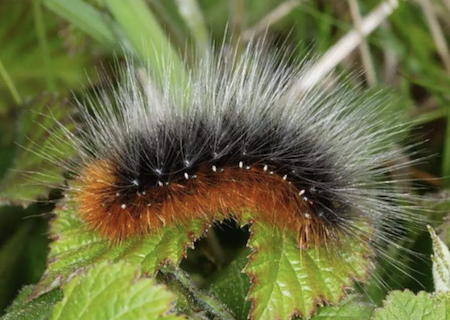
- Slug caterpillar: Larva is thick, short, stout and fleshy. Laval head is small and retractile. Larva has poisonous spines called scoli distributed all over the body. Such larva is also called platform larva.
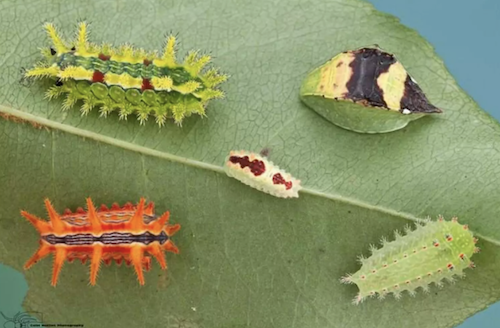
- Semilooper: Either three or four pairs of prolegs are present. Prolegs are either present or rudimentary in either third or third and fourth abdominal segments. e.g. Castor semilooper (Achoea janata).
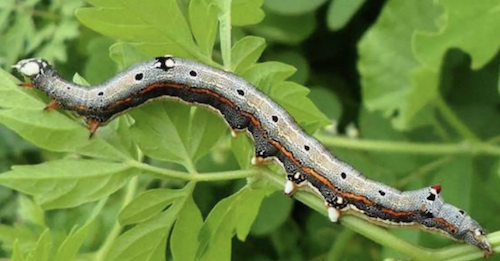
- Looper: They are also called measuring worm or earth measurer or inch worm. In this type, only two pairs of prolegs are present in sixth and tenth abdominal segments. During walking the insect body forms a complete loop like structure hence, the name looper. E.g. Mango looper (Thalassodes quadraria)

Apodous
- They are larvae without appendages for locomotion.
- Based on the degree of development and sclerotization of head capsule there are three subtypes.
- Eucephalous: Larva with well-developed head capsule with functional mandibles, maxillae, stemmata and antennae. Mandibles act transversely. e.g. Wriggler (larva of mosquito) and grub of red palm weevil.
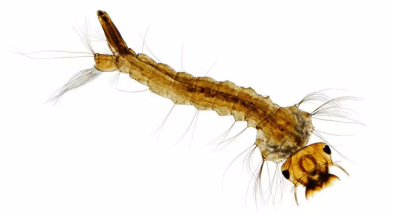
- Hemicephalous: Head capsule is reduced and can be withdrawn into thorax. Mandibles act vertically. e.g. Larva of horse fly and robber fly.
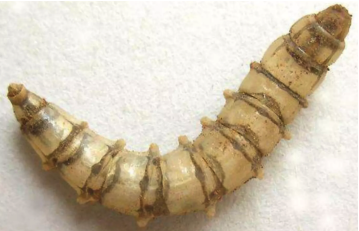
- Acephalous: Head capsule is absent. Mouthparts consist of pair of protrusible curved mouth hooks and associated internal sclerites. They are also called vermiform larvae. E.g. Maggot (lava of house fly).
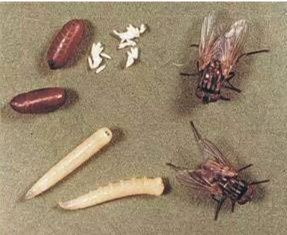
Pupa
- It is resting, inactive stage of the holometabolous insects and transitional phase during which the wings are developed, and the insect attain matured sexual organs.
- Pupa represents a pharate adult stage and later it emerges as adult, pupation may take place either in soil, or on the plant surface or within the webs.
Obtect
- Various appendages of the pupa viz., antennae, legs and wing pads are glued to the body by a secretion produced during the last larval moult.
- Exposed surfaces of the appendages are more heavily scleroitised than the inner surface.
- Chrysalis: It is an obtect type of pupa which has golden colouration and a stalk. E.g. butterflies (Lepidoptera).

- Tumbler: Pupa of mosquito is called tumbler. It is an obtect type of pupa. It is comma shaped with rudimentary appendages.
Breathing trumpets are present in the cephalic end and anal paddles are present at the end of the abdomen. Abdomen is capable of jerky movements which are produced by the anal paddles. This pupa is very active.
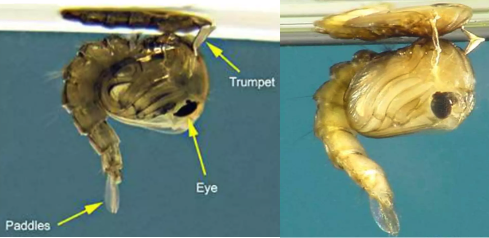
Exarate
- Various appendages viz., antennae, legs and wings pads are not glued to the body. They are free.
- All oligopod larvae will turn into exarate pupae.
- The pupa is soft and pale.
- E.g. most of the Coleoptera.
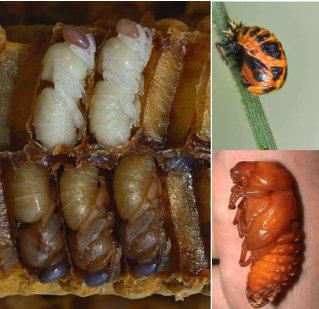
Coarctate
- The last larval skin is changed into a pupal case and the pupa is actually an exarate pupa.
- The pupal case is dark brown, barrel shaped, smooth with no apparent appendages and called as puparium.
- E.g. Fly pupa.
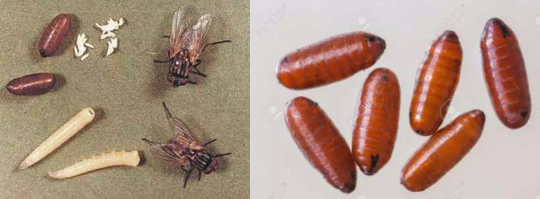
Pupal protection
- In general, pupal stage lacks mobility. Hence it is the most vulnerable stage.
- To get protection against adverse conditions and natural enemies, the pupa is enclosed in a protective cover called cocoon.
- Based on the nature and materials used for preparation of cocoons, there are several types.

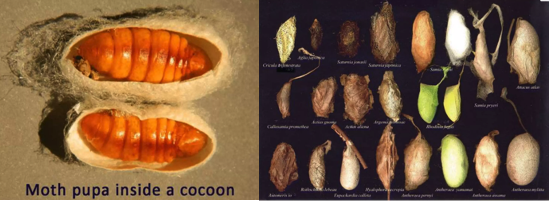
Silken Cocoon

Earthen Cocoon
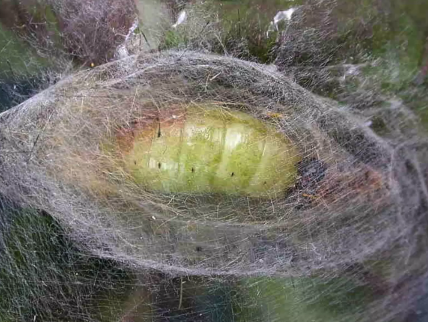
Hairy Cocoon

Frassy Cocoon

Fibrous Cocoon
References
- Insecta - Introduction: K.N. Ragumoorithi, V. Balasurbramani & N. Natarajan
- A General Textbook of Entomology (9th edition, 1960) – A.D. Imms (Revised by Professor O.W. Richards and R.G. Davies). Butler & Tanner Ltd., Frome and London.
- The Insects- Structure and Function (4th Edition, 1998) – R.F. Chapman. Cambridge University Press
- https://www.amentsoc.org/
- Researchgate
- Wikipedia
Which of the following statment is incorrect?
- Metamorphosis is the change in growth and development an insect undergoes during its life cycle from birth to maturity.
- Metamorphosis is derived from Greek word meta = Change, morph = form or structure.
- The presence of hard exoskeleton on the body prevents the growth of larva.
- The series of moults during larval stage allow them to increase their body size/growth.
- The number of moults in general may vary from 5-6.
Types of metamorphosis

Ametamorphosis

- Insects do not undergo any metamorphosis (No Metamorphosis).
- When the insect hatches from the egg, it resembles the adult in all the characters except the small body size, which later increases, until they reach sexual maturity with well-developed reproductive organs.
- E.g.: …
Become Successful With AgriDots
Learn the essential skills for getting a seat in the Exam with
🦄 You are a pro member!
Only use this page if purchasing a gift or enterprise account
Plan
Rs
- Unlimited access to PRO courses
- Quizzes with hand-picked meme prizes
- Invite to private Discord chat
- Free Sticker emailed
Lifetime
Rs
1,499
once
- All PRO-tier benefits
- Single payment, lifetime access
- 4,200 bonus xp points
- Next Level
T-shirt shipped worldwide

Yo! You just found a 20% discount using 👉 EASTEREGG

High-quality fitted cotton shirt produced by Next Level Apparel